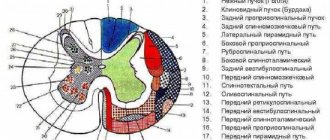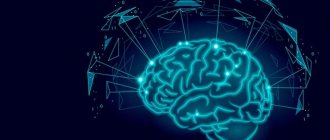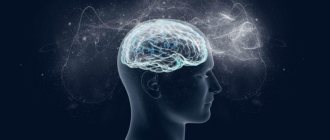Mental processes are a conditional division of the psyche into component elements that allow us to cognize the external and internal world. This is such a complex phenomenon and so little is known about it that there are quite a few definitions and interpretations of this phenomenon.
The development of mental processes occurs in specific conditions of interaction with the outside world: the special properties of our planet, the transition from winter to summer, changes in gravity and much more - put forward certain requirements for a person. Therefore, the psyche acts as a regulator of the body’s behavior.
The functions of mental processes depend entirely on the species. All mental processes can be divided into three types:
Cognitive:
- perception;
- memory;
- thinking;
- sensation;
- imagination;
- performance;
- speech;
- attention.
Emotional:
- feelings;
- emotions;
- stress;
- affects.
Strong-willed:
- will;
- goal setting;
- decision-making.
There is also an inseparable interconnection of mental processes, which is expressed, for example, in the fact that memory is impossible without attention, perception is impossible without memory, and so on. Therefore, if you want to improve the functioning of your mental processes, it will be enough to develop several of them. For example, memory, imagination, emotions and will. However, your list may be completely different. In any case, it should not surprise you that by developing your attention, all other processes immediately “catch up”.
Study methods
In the field of psychiatry and cognitive science, the following methods are used to study the processes of memory, perception, thinking, attention and other functions:
- Recognizing figures by touch and manipulating them tactilely (Seguin board).
- Visual recognition of real, noisy, contour and defocused images (Poppelreiter test).
- Perception of objects requiring visual-spatial processing (contour geographical map, schematic clock).
- Recognizing familiar portraits of famous people.
- Listening perception and assessment of rhythmic structures.
- Detection of memory impairments (Pictogram technique).
It should be said that it is possible to identify a violation of the mental process only with the help of several methods, that is, problems need to be diagnosed in a complex manner.
The largest number of techniques explore thinking. The most famous is “Classification of Objects”, where it is possible to study various aspects of the thinking process. Also known: understanding the figurative meaning of metaphors and proverbs, solving arithmetic problems of varying degrees of complexity, comparing and defining concepts.
Now let's talk separately about the course of mental processes and states, their characteristics, properties and functions.
Issues
Due to mental disorders, development is inhibited, problems arise with perception and assimilation of new information. Perception disorders:
- false recognitions;
- deception of feelings;
- distortion of perceived objects.
Thinking disorders:
- revaluation of ideas;
- delirium;
- obsessive thoughts.
Memory impairments:
- cryptomnesia;
- confabulation;
- echonesia.
Emotional disorders:
- hyperthymia;
- euphoria;
- depression;
- obsessive emotions;
- confusion.
Mental cognitive processes
Let's consider each process separately.
1
Perception
Perception is a holistic reflection of objects and phenomena in the totality of their properties and parts with their direct impact on the senses. It occurs in close relationship with other mental processes: first of all, with sensations that, with the help of sensors, collect information from the outside world, and secondly, with memory, will and attention. Perception is the interpretation of what our sensors have collected.
Perceptual properties include:
- Structurality: an object is perceived by consciousness as a simulated structure abstracted from sensations.
- Objectivity: objects are perceived not as an incoherent set of sensations, but as images that make up specific objects.
- Constancy: constancy of perception of the same object.
- Apperception: perception is influenced by the general content of the human psyche.
- Selectivity: preferential selection of some objects over others (perception here works closely with attention).
2
Memory
Memory is a complex of cognitive abilities for the accumulation, preservation and reproduction of knowledge and skills. Memory is closely related to thinking, perception and sensations.
The main function of memory is to store information, which a person can then use for certain purposes. Without it, we would not have an identity.
The properties of memory include: volume, accuracy, speed of memorization and forgetting processes.
There are different typologies of memory:
- By content: spatial, social, emotional, eidetic, sensory, verbal-logical, figurative.
- By sensory modality: motor, visual, gustatory, auditory, olfactory, eidetic, pain.
- By storage time: long-term, short-term, ultra-short-term.
- According to the organization of memorization: declarative and procedural.
- According to the presence of a goal: voluntary and involuntary.
3
Thinking
Thinking is the process of modeling the patterns of the surrounding world, the highest stage of human information processing. We can say that this is the final mental process that guides the personality.
With the help of thinking, a person can completely change his perception, imagination, attention, will and even sensations. The highest degree of human knowledge.
Basic characteristics of thinking:
- Indirect cognition of objective reality: even on the basis of indirect information we can judge the properties of objects and phenomena.
- Generalization of the reflection of reality: the transition from individual objects to the general.
4
Feel
Sensation is a mental reflection of individual properties and states of the external environment, subjects of external or internal stimuli with the participation of the nervous system.
Canonically, there are five types of sensations: smell, taste, touch, vision, hearing.
Properties of sensations:
- Intensity: a quantitative characteristic of sensations.
- Modality: qualitative description of sensations.
- Duration: temporary characteristic of sensations.
- Localization: spatial characteristics of sensations, information about the location of the stimulus in space.
5
Imagination
Imagination is a person’s ability to create images, ideas and ideas in the mind, as well as to manipulate them. The functions of imagination are to imagine in the head a sample of the future result of an activity in planning, searching for a strategy for solving problems.
Properties of imagination:
- Dream: an emotional image of a desired future that is characterized by little knowledge of how to make it a reality.
- Creativity: creation of new spiritual and material values.
- Agglutination: the creation of new images based on “gluing together” parts of existing images.
- Hallucination: unreal images that a person experiences during illness.
- Emphasis: creating new images by highlighting and emphasizing certain features.
6
Performance
A representation is an image of a phenomenon or object that a person does not perceive here and now. It differs from imagination in that a person is simply trying to remember the image, and not come up with something new.
The functions of representation depend on the type of human activity: artists need to remember the desired image, musicians need to remember the desired melody or sound. Imagination helps to solve complex and imaginative problems, including creative ones.
View properties:
- Fragmentation. The more attractive an object was to a person, the more detail he can imagine it.
- Visibility. A person represents the image of a perceived object exclusively in visual form.
- Generality. The image of an object has a certain information capacity.
- Instability. The image can only be held for a certain amount of time.
7
Speech
Speech is a form of communication between people through linguistic structures. Inherently connected with thinking and presentation.
It helps convey important information to us, as well as convey socio-historical experience.
Properties of speech:
- Clarity. Syntactically correct construction of sentences, the ability to correctly pause or place logical emphasis on the right word.
- Content. The percentage of valuable words expressed in relation to those that are not valuable (the so-called “water”).
- Effectiveness. The influence of speech on the thoughts, will and feelings of other people.
- Expressiveness. Emotional richness, richness and variety of linguistic means.
8
Attention
Attention is the selective focus of perception on a particular object. It is very closely related to memory (some cognitive scientists believe that this is one and the same thing), as well as will.
With the help of will, a person can change his attitude towards an object and pay conscious attention to it, that is, highlight it from the rest. Attention helps a person to successfully navigate the world around him.
By the properties of attention one should mean: volume, direction, concentration, distribution, intensity, switchability and stability.
Kinesthetic (motor) sensations – sensations of movement and position of body parts
Do a little experiment. Close your eyes and stand in some position: follow the command “at attention”, and then take the same position again. Think about which of the five senses helped you repeat the movement? It was moving 12
a painful sensation
caused
by irritation of receptors located in muscles, ligaments, and joints.
When walking, dancing, cycling, we feel a change in the speed or direction of our movement thanks to the vestibular apparatus of the inner ear.
Vibration sensations - occur when the surface of the body is exposed to air vibrations produced by moving or oscillating bodies
They play an important role in the deaf and blind. With the help of these sensations, deaf-blind people learn about the approach of a vehicle or a person, touching the lips of a speaking person and feeling their vibration, they can learn the alphabet and then speak.
are distinguished separately .
There is evidence that a person, with the help of ordinary senses, can perceive stimuli that are beyond the lower threshold of his sensitivity, that is, a person reacts not only to those signals that he is aware of, but also to those that he is not aware of. Premonition and foresight are built on this.
Abram Pshonik conducted an experiment with his daughter in 1952. In the kitchen during breakfast, the daughter kept her finger on the button to which the current was connected. When the light came on, the current flowed, you had to have time to take your finger off the button. Over time, the girl, without the light bulb, withdrew her finger, reacting to subthreshold sensations. Together with the light bulb, Pshonik turned on a generator of high-frequency sounds that were not audible to the ear, the girl reacted to these sounds.
Mental emotional processes
Let's consider each process separately.
1
Feelings
Feeling is a human emotional process that reflects a subjective evaluative attitude towards abstract or real objects. Feelings manifest differently among people because they are influenced by their own set of individual traits and personality traits. Necessary for communication, friendship and understanding of other people.
Properties of feelings:
- Content: reflection of various aspects, features of the meaning of the objects that cause them.
- Sthenicity: sthenic feelings mobilize a person’s strength, encourage him to active activity (hate, love). Asthenic paralyzes and relaxes (contempt and fear).
- Intensity: strength of feeling.
- Valence: pleasant, unpleasant and ambivalent feelings.
2
Emotions
Emotions reflect a subjective evaluative attitude towards objects, phenomena, situations and people. With the help of will, a person can evoke any emotion that he deems necessary.
The properties of emotions completely coincide with the properties of feelings.
3
Stress
Stress is a set of adaptive reactions of the psyche to stressors.
There is positive (eustress) and negative (distress) stress. The difference is in intensity: the more of it in the psyche, the worse.
4
Affects
Affects are emotional processes of an explosive nature. In many cases they are considered a negative manifestation of the psyche, but in a threatening situation they can save lives.
Perception factors
Our perception depends on external and internal factors.
a) External factors: - intensity of the stimulus; — size of the stimulus; — stimulus contrast; - movement of the stimulus; - recognition of the stimulus.
b) Internal factors: - human attitude; — needs; - experience; — personal characteristics (self-esteem, left- or right-handedness, optimism-pessimism, etc.); - effects of perception.
Mental volitional processes
Let's consider each process separately.
1
Setting a goal
Goal setting is the process of selecting one or more goals. Closely related to willpower and emotions.
2
Will
Will is the ability of a person to make a decision based on the thought process and direct his actions and thoughts in accordance with the decision made.
As follows from the definition, will is closely related to thinking and decision-making. But, besides this, without it conscious attention and developed memory are impossible.
3
Making decisions
Decision making is a mental process that is characterized by the use of willpower to set a goal and a firm intention to achieve it.
Effects of perception
Let us highlight the main effects (errors) of perception:
The projection effect is the ability of people to attribute their own advantages to a pleasant person, and their shortcomings to an unpleasant person. Those. the effect suggests that other people have the same qualities as the perceiver.
The halo effect is the formation of a specific attitude towards a person through the directed attribution of certain qualities to him; information received about a person is superimposed on the image that was created in advance. Those. the effect is to extend the general opinion to the particulars.
The primacy and recency effect is the tendency of people, when faced with conflicting information about another person, to give more weight to information received first (if a stranger is perceived) or more recent information (if an old acquaintance is perceived).
The effect of physiognomic reduction is the ability of people to draw conclusions about the character and psychological characteristics of a person based on the features of his appearance.
Development of mental processes
When they talk about the development of mental processes in children, the first thing they distinguish is their age group.
From 2 to 6 years of age, the child develops mental processes. Parents can influence this if they coach them. Here are exercises you can give your children:
- Place some toys on the table. The child must remember their location and presence. Then he closes his eyes and you remove or move one of them. He must say what has changed.
- When your child has mastered this exercise, make it more difficult. Remove 2 or 3 toys.
- The following game is suitable for developing thinking: place four pictures in front of the child, where three of them relate to a specific topic. The child must guess which one is extra.
- When going to the store, give your child a list of products (3-4 to start with) to memorize. In the store he must remember them (long-term memory is trained).
If your child is 7-8 years old, he should be able to:
- Find 10 differences between objects.
- Complete the task without distraction for about 15-20 minutes.
- Copy a movement or pattern exactly.
- Complete tasks independently according to the proposed sample.
- Be able to find identical objects.
- Be able to sequence events and compose a coherent story using pictures.
- Build a logical series from a specific group of objects.
- Repeat verbatim sentences consisting of 7-8 words.
The mental processes of an adult are formed at the age of 16. But this does not mean that they cannot be trained and improved. In fact, thinking can and even needs to be developed throughout life. Therefore, in conclusion of the article, we suggest that you take one of our courses (or all of them):
- Memory development
- Logical thinking.
- Emotional intellect.
- Cognitive science
Also, be sure to practice by solving problems from our “Games, Challenges and Entertainment” section.
We wish you good luck!
We also recommend reading:
- Storytelling
- Sensation and perception
- Exercises for memory development in preschoolers
- Human attention: what it is and how it works
- Spheres of personality
- Cognitive psychology and cognitive psychotherapy
- Cognitive processes
- Cognitive sphere of personality
- Sensations: what they are and what they are like
- Two important laws of memory
- Intelligence and its development: several recommendations
Key words:1Self-knowledge
Principles of perception
A group of psychologists, together with Max Wertheimer, a German psychologist and founder of Gestalt psychology, formulated the laws of perception, which became the theoretical basis of Gestalt psychology.
1. The principle of proximity Elements that are close to each other in space and time and that seem to us to be united in groups, we perceive together.
2. Principle of Continuity There is a tendency to follow a direction that allows observed elements to be linked into a continuous sequence or a specific orientation. In the figure we see not just individual dots, but two intersecting lines.
3. Principle of similarity Similar elements are perceived by us together, forming closed groups. Because of the color, we perceive the points in the figure as rows rather than columns.
4. Closure principle There is a tendency to complete unfinished items and fill empty spaces.
5. The principle of simplicity (the law of content, the principle of good form, the law of pregnancy) We perceive and interpret composite or complex objects as the simplest form or a combination of the simplest forms. In the figure we see three different simple figures, and not one complex one.
Pregnant gestalt means that in any conditions we strive to see the figures as complete as possible.
6. Figure-ground
We strive to organize our perception in such a way as to see the object (figure) and the background against which it appears. The object is brighter, more significant, and noticeable.
Classification of types of perception
1) Separation by modality: - visual perception; - auditory perception; - tactile perception; - taste perception; - olfactory perception. Combinations of different types of perception are possible.
2) Division by object of perception: - perception of space (includes the perception of size, shape, relative position of objects, their relief, distance and direction); — perception of time (reflection of the duration and sequence of phenomena or events); — perception of movement (reflection of the direction and speed of the spatial existence of objects); — perception of speed; - perception of direction; - perception of a work of art; - perception of the main phenomena of human life.
3) Separation by goal: - intentional (voluntary) perception (we are guided by a previously set goal or task); - unintentional (involuntary) perception (lack of volitional activity and purpose).
4) Division according to the participation of other psychological formations: - emotional perception (perception associated with emotions and feelings); — rational perception (perception subordinate to the thinking process).










